As demand for Western big game hunting continues to climb each season, it is more important than ever to have a well-thought-out application strategy. Putting together a solid strategy requires an understanding of when your point totals will offer the best value to cash in for each species in each state. As complex as it can be when considering all of the states that offer non-resident hunting opportunities, in this article we’re going to focus on the eight most popular states in the West for non-resident hunting applicants: Arizona, Colorado, Idaho, Montana, Nevada, New Mexico, Utah, and Wyoming.
Aside from over-the-counter sheep hunting in Montana, there is no real plan for hunting the “once-in-a-lifetime” species like moose, sheep, goat, and bison, except for being incredibly lucky in the draw. For this reason, the following will be focused on an elk, mule deer, and antelope application strategy and from a DIY hunter’s perspective. It’s also worth noting that the tables shown below do not account for point creep, but rather from where I feel the best values currently exist in each state.
In my opinion, the best hunting application strategy should include an even mix of short-, intermediate-, and long-term applications. To understand which states fit into each of those categories, they can most simply be broken down into three different groups: opportunity states, wild card states, and trophy states. There are some exceptions for some species in some of these states, and this grouping is a generalization to keep this breakdown simple.
The Opportunity States: Colorado, Montana, and Wyoming
These are the foundational states you should be taking advantage of to be going on a hunt every year. The best value in these states is in the three to five year range for most species. By cycling through each of these states while rebuilding the points for each species you’ve cashed in on, these states are vital for those looking to find themselves on a hunt every year. That won’t be the case If you’re chasing the best hunts in these states each year.
The Wild Card States: Idaho and New Mexico
Without a point system in place in Idaho and New Mexico, there’s no planning on when you’ll be hunting in these states. You’re simply at the mercy of the draw as to whether you will have a tag in your pocket from year to year. Without a point system, you can jump in and out of the draw each year if budget or schedule dictates doing so without hurting your chances of being drawn in the future.
The Trophy States: Arizona, Nevada, and Utah
While it’s mathematically possible to draw any tag in these states with little or even no points, the odds are incredibly long. Lower tag allocations keep trophy potential high and draw odds low. Middle of the road hunts in these states are not what I’m going after here. Instead, I’m swinging for the fences in hopes of drawing a hunt someday that will have me hunting in a unit that holds world-class animals. I don’t need a hunt in these states that only offers an opportunity at an average animal. That’s what the opportunity states are for.
With a better understanding of which states offer which types of opportunity, we‘ll break down a more detailed look at planning a short (one to three years), intermediate (five to 10 years), and long-term (15+ years) plan for each species. With the exception of Idaho and New Mexico, the hunts assigned to each column represent a 50% or higher probability of being drawn. The better over-the-counter hunts in these states are also represented in the one-year columns.
Elk
Colorado’s archery and rifle hunts are easily the most popular non-resident over-the-counter elk hunting option. There is no limit to the number of tags that may be sold to non-residents each year. While that is good news for a non-resident looking to get their elk fix, it also comes with a crowded elk hunting experience. At around three points for an archery hunter and around five for a rifle hunter, there are good options for hunts that will offer a much better experience than those of the OTC units.
While Idaho used to offer non-residents OTC elk tag opportunities, the state now uses an application and draw process for non-resident deer and elk tags (adopted for the 2026 season). In May and early June, you may also apply for controlled hunts, and with no point system in place, your odds for the more popular hunts will be in the 1%-10% range each year.
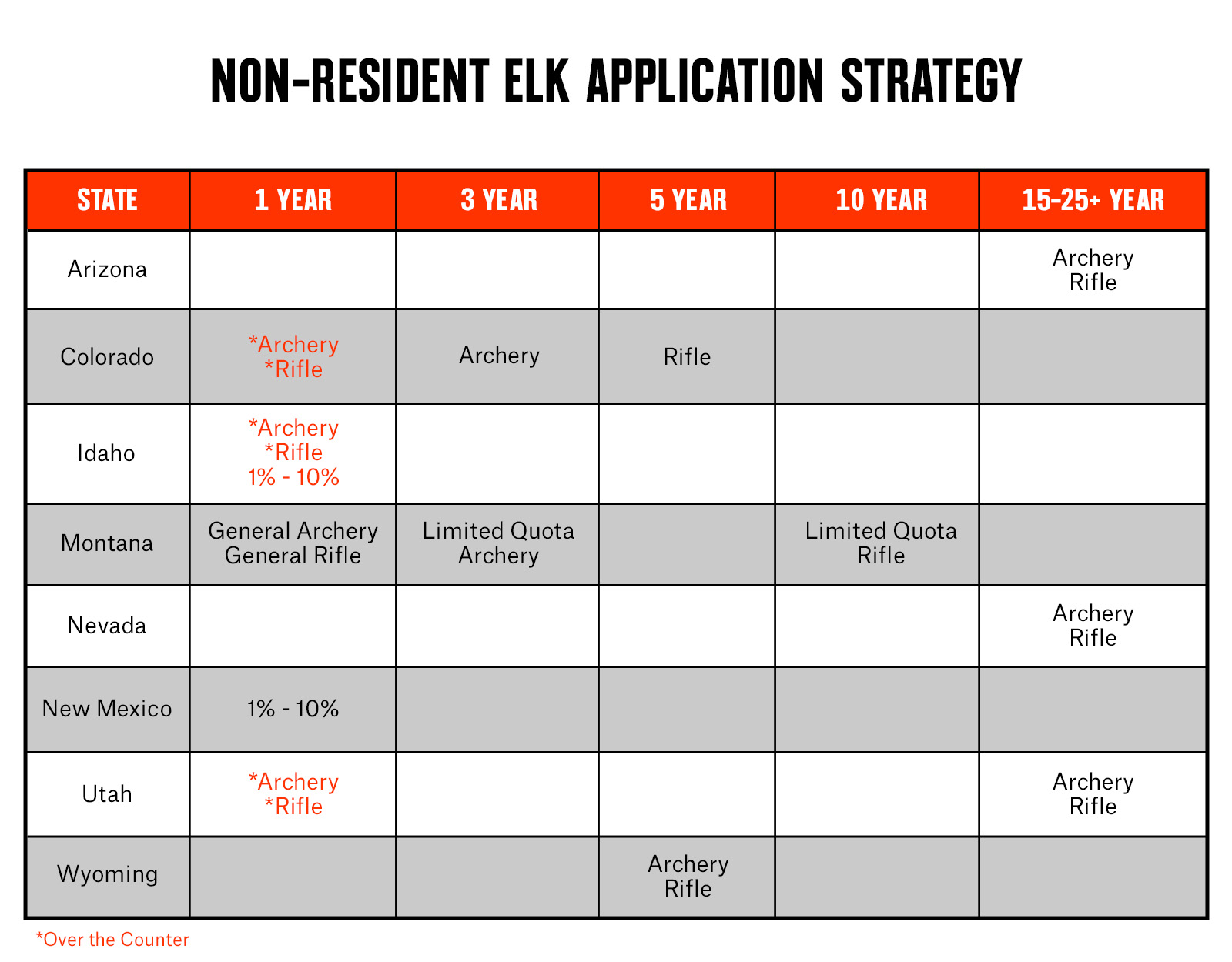
Montana’s draw system can be confusing, as you can apply for general elk licenses and also limited quota permit hunts. You have roughly a 60% chance of drawing a general elk license each year if you’re not participating in the preference point system. If you are participating in the preference point system, you can count on drawing a general license every two years. For limited quota hunts, three bonus points give an archery hunter a good shot at drawing some archery permits. The odds are longer for limited quota rifle hunts with 10 bonus points giving you a decent chance of being drawn. The way Montana runs its draw, you’ve always got a chance of drawing a limited quota hunt, no matter how many bonus points you have, so it makes sense to apply for limited quota hunts if you are already applying for a general license.
New Mexico, without a point system in place, offers a one to ten percent chance of drawing the more popular elk hunts.
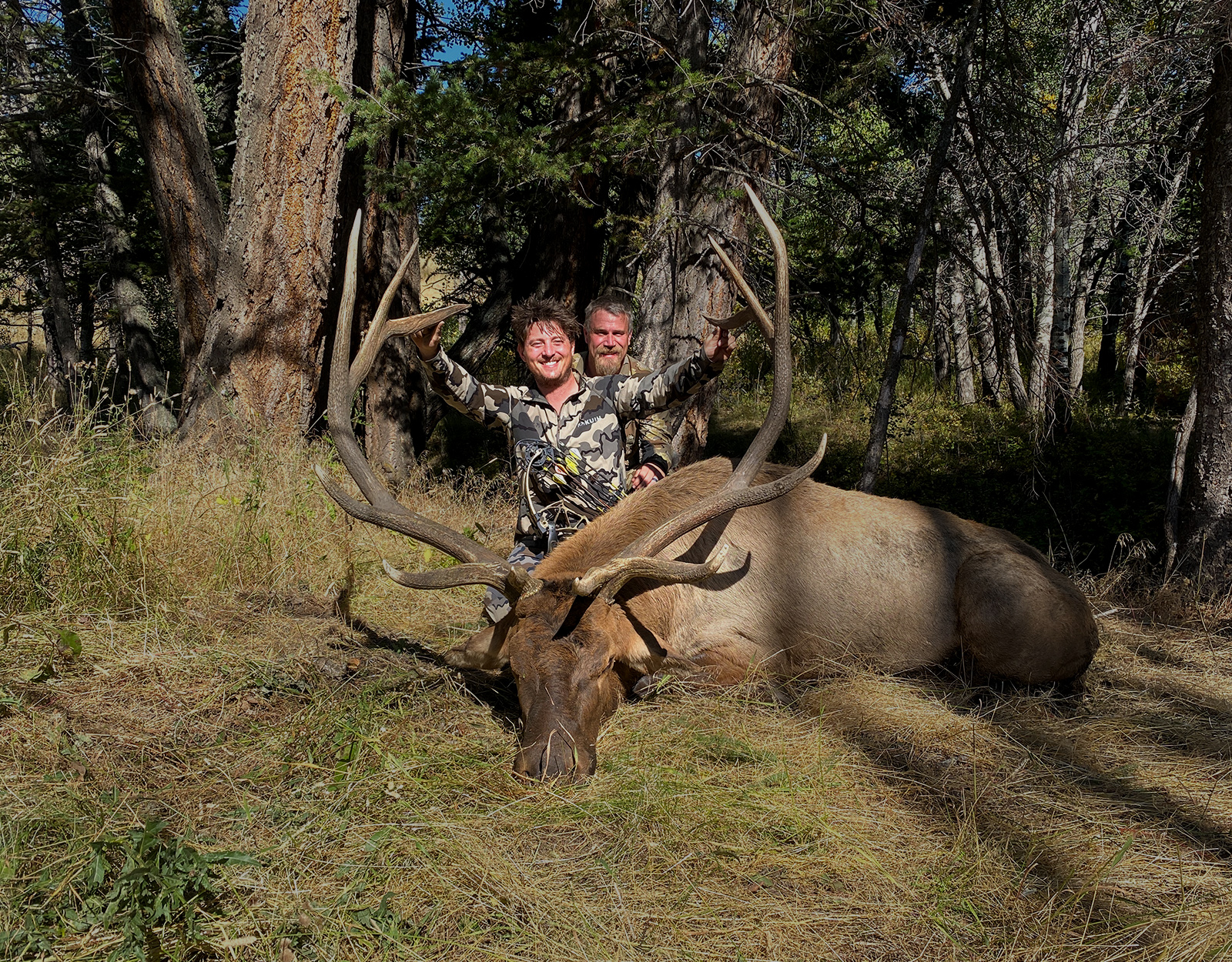
Utah has general season elk permits that go on sale in July. General archery elk permits are unlimited for non-resident hunters, while general rifle permit numbers are limited. Point creep in Utah for a limited-entry elk hunt has gotten out of control, and drawing a permit should be viewed as a long-term play. You’ve always got a chance at drawing along the way, but doing so means beating lottery-type odds. The same can be said of limited-entry elk hunts in Arizona and Nevada.
Wyoming split general elk units into 3 regions this year (2024) from a statewide general elk tag in prior years. In 2023, 4.1 points guaranteed this license in the regular draw and special draw. This is going to obviously change the draw odds and render these prior years draw statistics useless except for speculation. Wyoming also added close to 1,000 more nonresident elk tags, which further complicates this. Wyoming also raised the special elk license fee to $1,967, which, after your 2.5% online convenience fee, will bring your total to just over $2,000. This will also affect the draw odds for both regular and special, so it’s going to take a few years of the new system to get a feel for the level of points required to draw a general elk license.
Mule Deer
Arizona offers archery hunters over-the-counter tags for mule deer. There is a cap on the number of tags that may be sold to non-residents, as well as limits in place for the number of deer that may be harvested in each unit before it is closed. For limited-entry archery hunts, there are some options at around 10 points, but you’re in for a long wait if you’re trying to draw an archery Strip tag or one of the best rifle hunts in the state, which are currently taking 25 points to draw.
Colorado’s sweet spot for archery deer hunters begins at around three points. Determining the best value for its rifle deer hunts is more difficult because, between the multiple sets of rifle season dates, there are plenty of options for hunts to apply for. It’s fair to say that each point you accrue is going to return its value and get you on a slightly better hunt. Because of this, an argument could be made to put a rifle hunter’s best value in any of the three, five, 10, or even 15+ year categories. That being said, with limited short-term rifle options for mule deer hunting in the West, it makes sense for applicants to take advantage of the three-point type hunts if they are looking for a good mule deer hunt as often as possible.
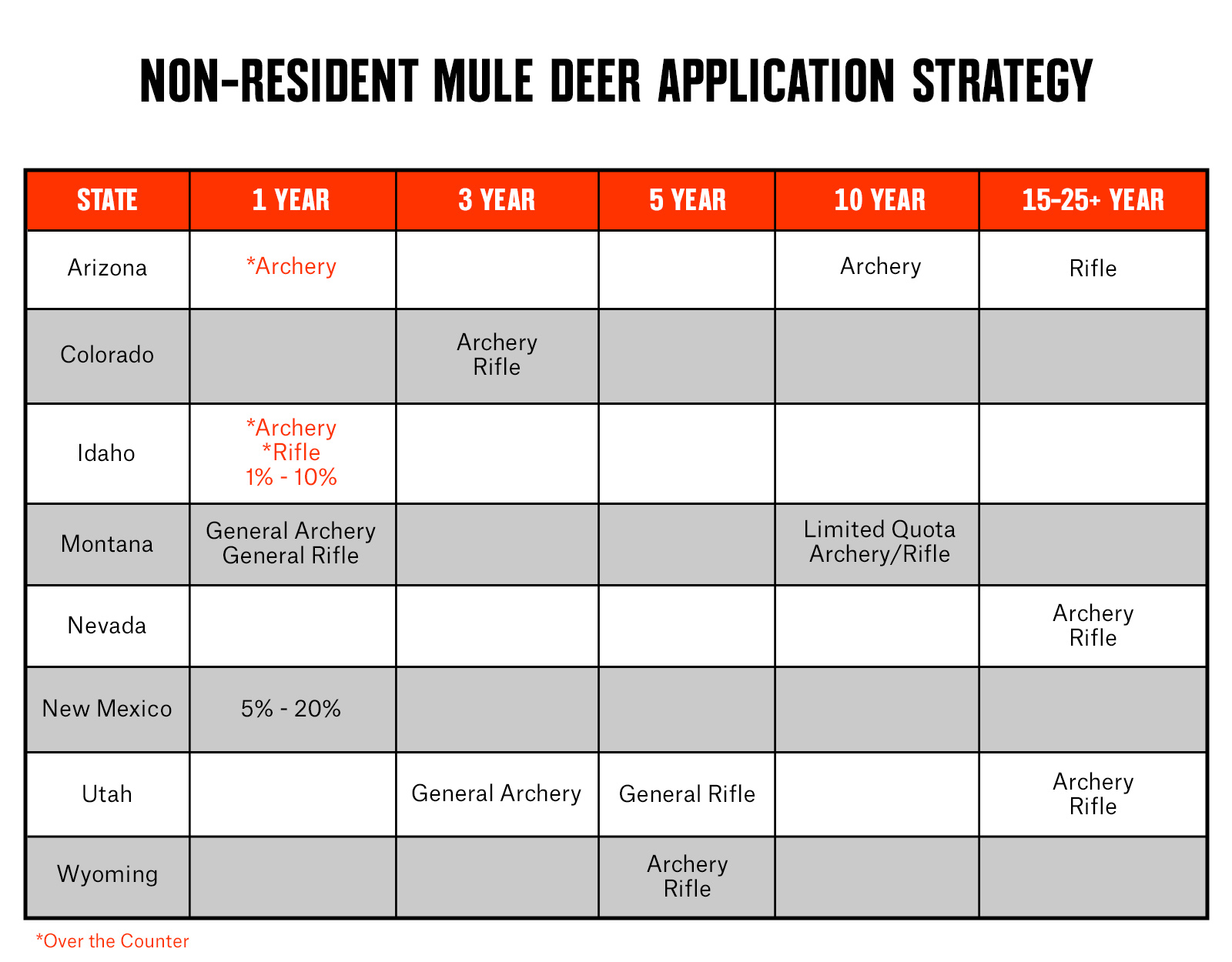
Idaho also offers non-residents the opportunity to purchase OTC tags in any of the general deer units across the state. Each comes with different season dates and weapon options. These tags are not unlimited for non-residents and are subject to a non-resident cap in each unit. To pick up one of these tags, you need to purchase one when they go on sale on December 1. In May and early June, you may also apply for controlled hunts, and with no point system in place, your odds for the more popular hunts will be in the 1%-15% range each year.
In Montana, you can apply for general deer licenses and also limited quota permit hunts. You have roughly a 50% chance of drawing a general deer license each year if you are not participating in the preference point system. If you are participating in the preference point system, you can count on drawing a general license every other year. For limited quota hunts, 10 bonus points get you in the game for a good chance at drawing a decent limited quota rifle hunt. Unfortunately for archery hunters, the same is true as there aren’t any archery-only hunts to apply for. To archery hunt limited quota units, you will have to apply for a rifle tag and hunt its archery season dates if drawn.
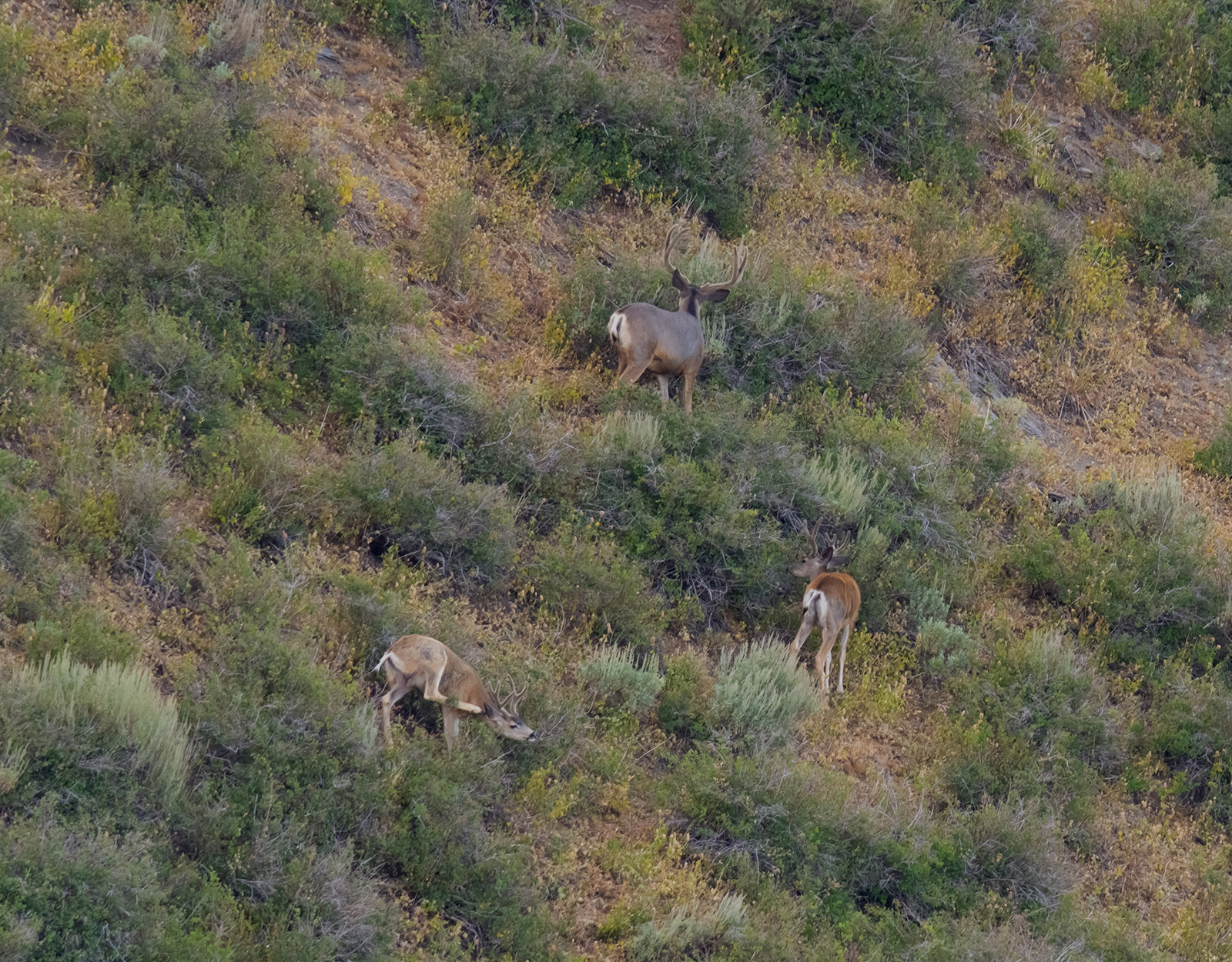
To get into one of the top units in Nevada that offer you a chance at taking one of the giant deer the state produces each year, you are going to be looking at a long-term application strategy. Only Arizona and Utah’s top hunts offer a better chance of finding a true giant than the top units in Nevada. With few states across the West offering top-end trophy mule deer hunts, I’ll take on the long draw odds and wait my turn for some luck in the draw. There are plenty of easier-to-draw options for those who aren’t concerned with how big of a deer they are hunting in Nevada.
New Mexico, without a point system in place, offers a five to 20 percent chance of drawing the more popular opportunity-type deer hunts.
In Utah, you can apply for two different types of deer hunts each year: general hunts and limited-quota hunts. What’s great about this system is that while you are applying for Utah’s best hunts in hopes of hitting the lottery, you can also cash in on your general deer points and be hunting a general unit occasionally along the way. Archery hunters will have good options at three points, while the better rifle hunts are taking five points to draw in the general units.
Like Wyoming’s elk hunts, the general region deer hunts in Wyoming give you a few good options at around five points. For me, it’s not worth chasing point creep to catch the better hunts in Wyoming if you are looking for a good mule deer hunt as often as possible.
Antelope
In Arizona, Nevada, New Mexico, and Utah, the odds of being drawn for an antelope hunt are rough. Of these states that have a point system in place, you’re going to need to be sitting on a pile of points or beat some long odds. Aside from Utah, each of these states offers great trophy potential and should be worth the wait when drawn.
Colorado sells unlimited over-the-counter archery antelope licenses in many areas of the state. However, many of those areas are comprised of private land, making access difficult. For limited-entry hunts, five points will get an archery hunter on a good hunt, and 15 points give a rifle hunter some good public land options.
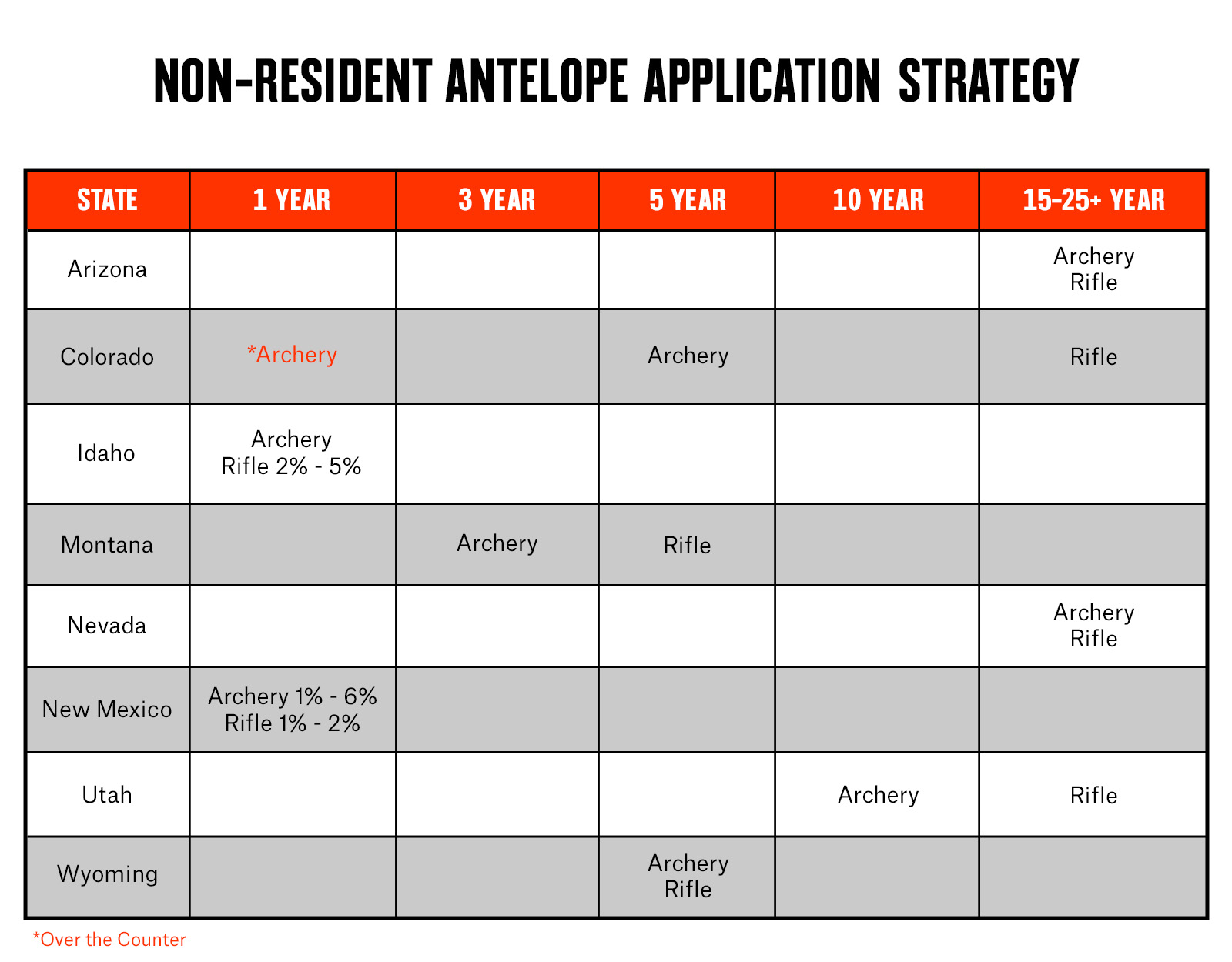
Idaho offers archery hunters a good number of unlimited quota archery hunts. You must apply in the controlled draw for them and use your first application choice to ensure being drawn for one. Many of these hunts offer good public access. There are also controlled archery hunts that are going to offer a little better potential for a better buck. Most of these hunts run anywhere between five and 50 percent draw odds. Rifle hunters are faced with two to five percent odds of being drawn for any of the controlled rifle hunts.
Montana has two different point systems for buck antelope: archery and any weapon. You may only apply for one of these hunts each year, but you can also build points for whichever one you didn’t apply for in the limited quota draw. The archery hunts are usually drawn with two or three points and are valid in any unit in the state in exception to three units. With five points, a rifle hunter will have a good probability of being drawn for a good unit with enough public land to have a good hunt.
Point creep for antelope in Wyoming has really taken off over the last couple of years, and we’ve seen some of the easier-to-draw hunts double in the amount of points it takes to be drawn over that span. As it stands now, most of the options for decent public land hunts don’t begin until you’re sitting on around five points. Aside from only a few exceptions, archery hunters will need to apply for a rifle tag and hunt the archery only season dates if drawn.
In addition to the strategy and options outlined above, most of the states I’ve focused on here provide some muzzleloader options as well. With the varying limitations on muzzleloader restrictions between each of these states (as well as in the interest of trying to keep this breakdown as simple as possible), those options weren’t covered.
If your Huntin’ Fool membership includes access to speak with the Hunt Advisors and you need help fine-tuning your application strategy, you can always give us a call. With a better understanding of when and which states make the most sense to be spending your points in, you will be making the most of your hunting opportunities by beginning each application season with a well-planned application strategy.
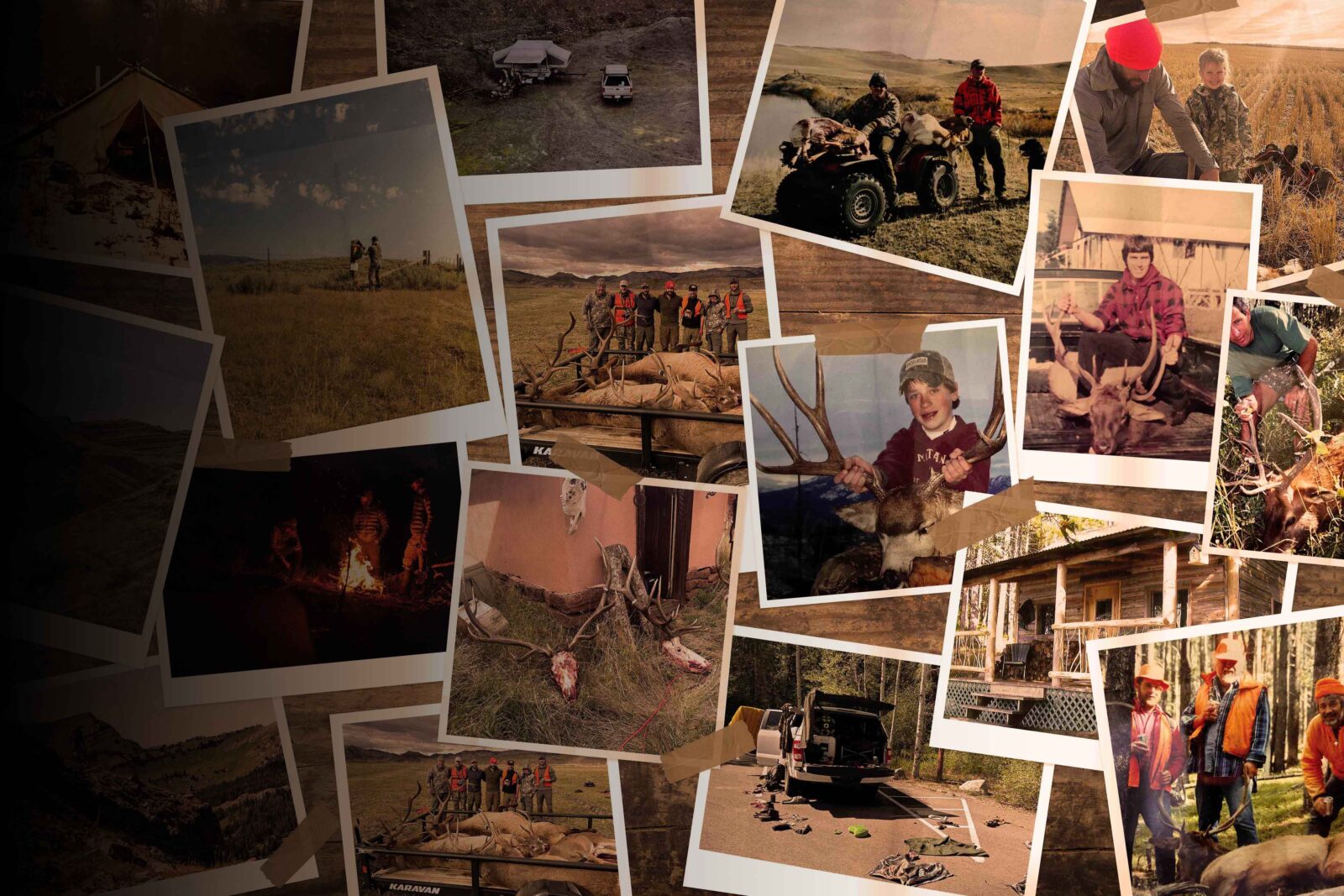

Your Complete System for Securing Tags
Whether you’re chasing a once-in-a-lifetime hunt or just looking to fill the freezer, your season starts with onX Hunt’s application tools—all included with an Elite Membership:
- Hunt Research Tools: Draw odds, tag trends, and harvest stats for 11 western states (Washington is not yet available) to help you decide where to apply.
- Huntin’ Fool: In-depth insights to navigate state-specific systems and build better strategies.
- HuntReminder: Text and email alerts so you never miss a deadline.
One membership, every tool you need to make 2026 the year.
